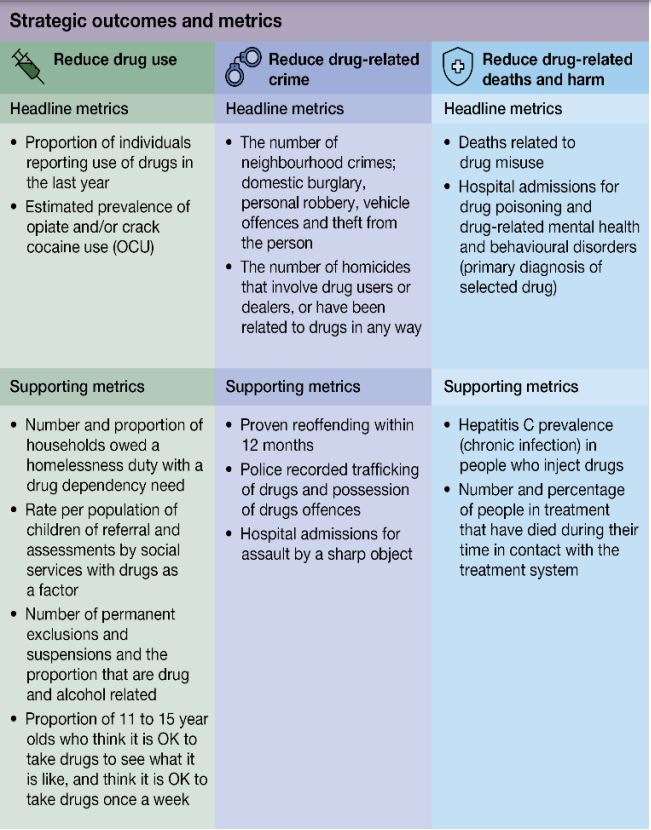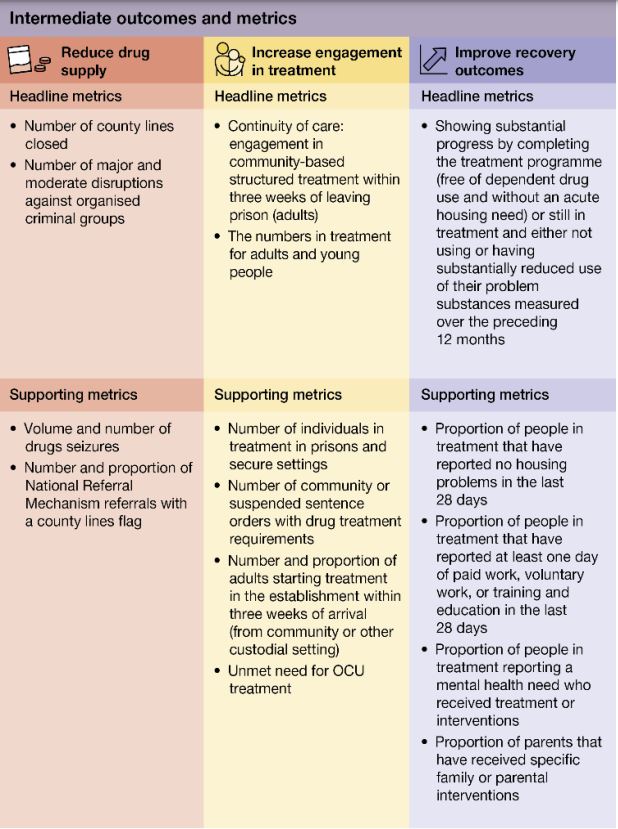

On 22nd May, the government published the National Combating Drugs Outcomes Framework, setting out the metrics through which they will measure progress towards the goals of the From Harm to Hope ten-year drugs strategy. The government’s intention is that the drug strategy fulfils 6 objectives, of which 3 are ‘strategic outcomes’ and 3 are ‘intermediate outcomes’. The strategic outcomes are (1) reducing drug use, (2) reducing drug-related crime, and (3) reducing drug related deaths and harm. The intermediate outcomes are (4) reducing drug supply, (5) increasing engagement in drug treatment, and (6) improving drug recovery outcomes.
This Outcomes Framework provides more information on how the government intends to measure progress along these outcomes, i.e., how it will tell if the strategy is working. Building on last years’ guidance for local delivery of the drugs strategy, which set out the strategy’s 11 ‘headline measures’ of progress, the National Combating Drugs Outcomes Framework sets out 22 ‘supporting metrics’ for more fine-grained evaluation of the direction of travel, providing a wider picture of system health and trends.
As Combating Drugs Minister, Chris Philp MP will have overarching responsibility for the strategy and its outcomes – and will report to Parliament annually on progress – but all relevant departments and agencies, including the NHS, local authorities, and prisons, are answerable to the strategy and its outcomes.
In addition to these 33 measures, to be used for monitoring the performance of the strategy nationally and locally across central government, the Office of Health Improvement and Disparity (OHID) will be responsible for monitoring 10 additional measures relating to the treatment and recovery system, which are also listed below.
1 – Reducing drug use
The first strategic outcome is an intended reduction in drug use, with the ambition being that overall use is reduced to a 30-year low.
The headline measures are:
i) the proportion of individuals reporting drug use in the last year (Source: Office for National Statistics [ONS], and NHS Digital)
ii) the prevalence of opiate and crack use (Source: Public Health England [PHE]).
Alongside these headline measures will be the supporting metrics, measuring:
a) the number of homeless households with a drug dependency need (Source: Department for Levelling Up, Housing and Communities);
b) the number of children in need with drugs as an assessed factor (Source: Department for Education[DfE])
c) the proportion of permanent school exclusions and suspensions that are drug and alcohol related (Source: DfE);
d) the proportion of 11 to 15 year olds who think it is OK to try drugs or take drugs once a week (Source: NHS Digital)
Additionally, OHID will have responsibility for measuring the estimated number of adults with an alcohol dependency (Source: PHE)
2 – Reducing drug-related crime
The second strategic outcome of the drugs strategy is the reduction of drug related crime, intending to contribute to the prevention of 750,000 crimes through increasing drug treatment provision. Measures of drug related crime differ from the other metrics listed in that they will be measured for both England and Wales, as opposed to England alone, as the law enforcement and criminal justice elements of the drugs strategy cover both England and Wales.
The headline measures are:
iii) the levels of drug-related homicide (Source: ONS)
iv) neighbourhood crime, made up of domestic burglary, personal robbery and theft, and vehicle offences (Source: ONS)
The supporting measures are:
e) the rate of proven reoffending within 12 months (Source: Ministry of Justice, [MoJ])
f) police-recorded trafficking of drugs and possession of drugs (Source: ONS)
g) hospital admissions for assault by sharp object (Source: NHS Digital)
3 – Reducing drug-related deaths and harm
The final ‘strategic objective’ is the reduction of drug-related deaths and harm, with the ambition to prevent 1,000 deaths over the three years to March 2025.
The headline measures are:
v) deaths related to drug misuse (Source: ONS)
vi) hospital admissions for drug misuse (NHS Digital)
The supporting measures are:
h) the number and percentage of people in treatment who have died during their time in treatment (Source: ONS)
i) the prevalence of Hepatitis C (chronic infection) in people who inject drugs (Source: UK Health Security Agency)
Additionally, OHID will have responsibility for monitoring the rate per population of registered deaths where alcohol is the primary cause (Source: PHE), the number of hospital admissions attributable to alcohol (Source: NHS Digital), and the number of hospital admissions among young people where the primary or secondary reason was due to substance misuse (Source: OHID public health profiles).
4: Reducing drug supply
The first ‘intermediate outcome’ is the reduction of the supply of drugs, with the ambition of closing over 2,000 more ‘county lines’ and 20% more major and moderate disruptions of organised crime.
The headline measures are:
vii) the number of county lines closed (Source: Home Office internal information)
viii) the number of moderate and major drug disruptions against organised criminals (Source: National Crime Agency internal information)
The supporting measures are:
j) the number and volume of drug seizures of all drug types (Source: Home Office internal information) and the number of incidents of drug finds in prisons (Source: HMPPS)
k) national Referral Mechanisms referrals regarding county lines (Source: Home Office)
5 – Increasing engagement in drug treatment
The government intends a ‘phased expansion of treatment capacity’ with at least 54,400 new high-quality treatment places to be made available.
The headline measures are:
ix) the numbers of adults and young people in treatment (Source: OHID)
x) prison continuity of care: adults with substance misuse need who successfully engage in community-based structured treatment following release from prison (Source: OHID)
The supporting measures are:
l) the number of community or suspended sentence orders with drug treatment requirements (Source: MoJ & HMPPS)
m) unmet need for opioid and crack usage treatment, based on comparison of prevalence and numbers in treatment (Source: OHID)
n) the number of people in treatment in prisons and secure settings (Source: OHID)
o) the number and proportion of adults starting treatment within three weeks of arrival in prison (Source: OHID).
Additionally, OHID will have responsibilities for monitoring unmet need for alcohol treatment, the uptake (in number and percentage) of residential rehab provision, and the uptake (in number and percentage) of inpatient treatment provision.
6 – Improving drug recovery outcomes
The final outcome to be measured is improvements in drug recovery outcomes.
The headline measure is:
xi) treatment progress in terms of programme completion or cessation/substantial reduction in use of problem substances (Source: OHID)
The supporting measures are:
p) the proportion of people in treatment in stable accommodation, reporting no housing problems in the last 28 days (Source: OHID)
q) the proportion of people in treatment who have reported at least one day of paid work in the last 28 days (Source: OHID)
r) the proportion of people in treatment who have reported at least one day of voluntary work in the last 28 days (Source: OHID)
s) the proportion of people in treatment who have reported at least one day of training or education in the last 28 days (Source: OHID)
t) mental health treatment and interventions provided for people in treatment (Source: OHID)
u) the percentage of parents who have received specific family or parental interventions (Source: OHID)
v) the percentage of young people who have ceased using drugs by treatment exit, excluding cannabis, alcohol, or nicotine (Source: OHID)
Additionally, OHID will have responsibility for monitoring the cessation of cannabis use and high risk drinking in young people.
Related Content
Collective Voice responds to the 10-year health plan
When the plan trumpets ‘a devolved and diverse NHS’, I wonder if it should really be saying ‘ a devolved and diverse health system’ Read
Collective Voice responds to the Independent Sentencing Review
There’s lots to welcome for our field, but the Government should approach some recommendations with caution. It would be a mistake to develop solutions today
The Government’s serious approach to synthetic opioids is welcome, but it can do more to provide national leadership
The Government is asking local areas to develop local preparedness plans and submit them for it to review. We can reasonably ask: what is in